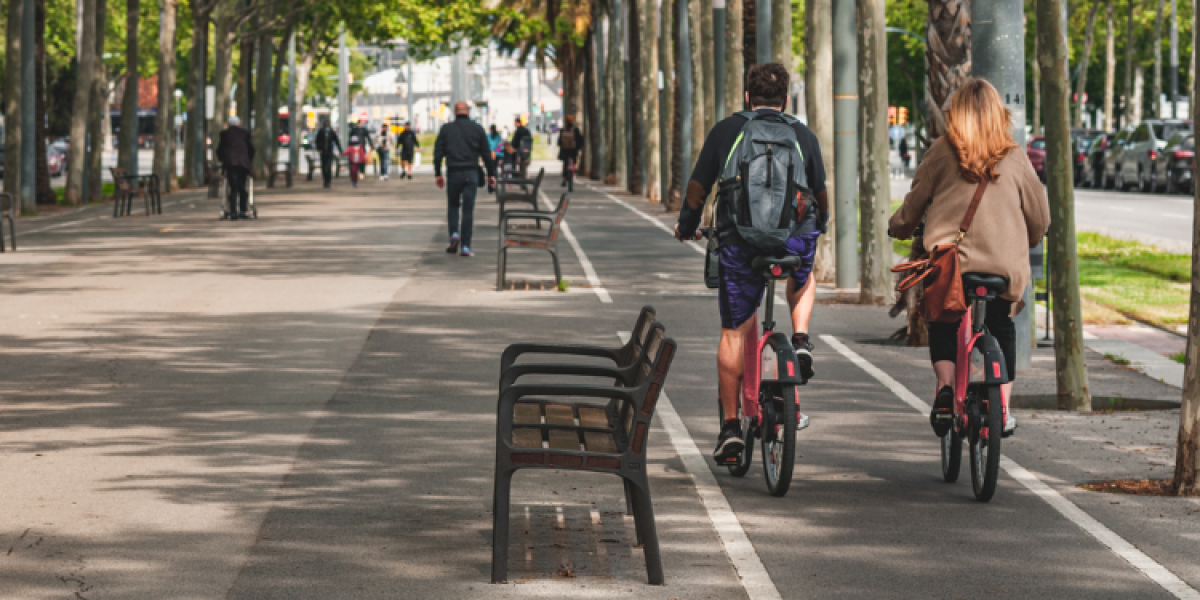
Moving abroad often serves as the perfect moment to change your habits: expanding your social circle, improving lifestyle choices, and altering your modes of consumption and transportation. Have you been primarily dependent on cars until now? Why not take the opportunity of moving to a new city to make a radical shift towards better health and the environment by adopting walking and biking? These modes of transportation are increasingly popular in large international cities and are indeed driving their development.
The benefits of biking and walking in figures
A unique study by the Pasteur Institute and the CNAM shows that cycling helps avoid nearly 2,000 deaths per year (based on data from France, where the study was conducted), and each kilometer cycled saves 1 euro in social health costs. The results are equally applicable in other Western countries. While it is known that walking and biking are good for health, this new study provides precise figures. "When a person cycles for 1 hour and 40 minutes per week, they reduce their risk of death by 10%". One of the institute's researchers calls it "an untapped potential."
Biking and walking are undeniably beneficial to our health, and their positive effects go beyond individuals. A European Cyclists' Federation (ECF) study estimates that the bicycle economy has created 654,909 full-time equivalent jobs in the European Union. The sectors considered include retail (mainly sales and repair), manufacturing, infrastructure, bicycle-related tourism services, and other logistical aspects.
On a global scale, the Statista Institute confirms revenues of 62.80 billion dollars from the bicycle industry, with a regular annual growth rate of 2.19% (projected through 2029). This growth is attributed to the increasing popularity of electric bicycles and cycling as a recreational activity and eco-friendly mode of transportation. Innovation also drives dynamism in these areas: performance of batteries, ABS brakes, integrated suspensions in bike frames, connected dashboards, solar sensor helmets, etc. These are innovations to count on in the future, notes Geo Magazine.
The top 10 cities for walking and biking
There is nothing like discovering a new city by exploring it at a pace that allows you to observe its details. Forbes magazine ranks the best cities for walking. The survey is based on various criteria, such as the walkability of the cities, the distances between main points of interest, air quality, and safety, without which walking would not be enjoyable. The top 10 from first to tenth place: Florence (Italy), Riga (Latvia), Hamburg (Germany), Porto (Portugal), Madrid (Spain), Edinburgh (United Kingdom), Tallinn (Estonia), Stockholm (Sweden), Sydney (Australia), Boston (USA).
As you can see, most of these cities are located in Europe, with only Sydney and Boston making it into the top 10. You have to go down to 26th place to find an Asian city (Shanghai) and 30th place for a city in the Middle East (Dubai). The impact of pollution and infrastructure favoring cars, as seen in some Asian, Middle Eastern, and North American cities, is well-known.
Regarding biking, European countries still dominate, according to another study reported by the French newspaper Le Figaro, which is based on the Global Bicycle Cities Index conducted across 90 cities worldwide. The indicators include weather, safety, infrastructure, and bike-sharing opportunities. The top 10 is dominated by 9 European cities, with Utrecht in the Netherlands scoring particularly high, followed by Munster (Germany), Antwerp (Belgium), Copenhagen (Denmark), Amsterdam (Netherlands), Malmö (Sweden), Hangzhou (China), Bern (Switzerland), Bremen (Germany), and Hanover (Germany).
Unsurprisingly, the Nordic countries dominate, as bike use is deeply embedded in their culture. In Utrecht, you will find the world's largest bike parking garage (12,500 spaces spread over several levels), and it is estimated that in this city, one-third of the population uses their bike daily, thanks to policies implemented decades ago.
How do you adapt your habits to favor walking and biking?
It goes without saying that one would not be inclined to bike or walk in cities where pollution prevails and infrastructure for pedestrians and cyclists is insufficient. The reliance on cars is particularly strong in various cities in the USA and Germany, for example, where it is sometimes more of a cultural habit than a real necessity. In response, some favor public transportation exclusively. But what if we really implemented a variety of alternative means?
Try to seize this opportunity to discover your new environment better and with more authenticity. Gradually integrate walking and biking into your daily routine. Start with short trips and gradually increase the distance. As is often said in Nordic countries, the right equipment makes all the difference. Invest in a good pair of walking shoes and a bike suited to your needs. Classic or electric? Think about how you will use it, the possibilities for charging your bike, if necessary, and other accessories that can significantly facilitate your travels and transport your belongings (side bags, trailers common in northern countries). Depending on the climate, consider appropriate clothing, such as raincoats or breathable garments. Finally, do not neglect regular maintenance, which is the basics you can learn yourself.
There are also numerous applications that will make your bike or walking trip easier. From route planning and voice guidance to real-time tracking, integration of tourist spots and rental terminals, and performance analysis, you will find several integrated services. Check out, for example, apps like Komoot, Bikeradar, Citymapper and Strava (to name just a few).
Walking or biking also gives you the opportunity to join local communities if you want to combine the useful with the pleasant. As a foreigner in a new country, biking and walking—beyond their sole function of moving—can allow you to socialize and meet people with similar interests, making your integration easier. You will find many groups on social networks or local clubs.



















